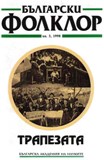Златната трапеза на цар Мидас
Tzar Midas’ Gold Table
Author(s): Maya VasilevaSubject(s): Anthropology
Published by: Институт за етнология и фолклористика с Етнографски музей при БАН
Summary/Abstract: The work is devoted to the mythological group of evidence about the Phrygian king Midas. The literary shaping of the story about his punishment by the gold food which doomed him to starvation was done by Ovid. The poet of the time of Augustus gave a final touch to the Alexandrine scholastic tradition. The “golden touch” of Midas was almost absent from the earlier pieces of written evidence. The objects which the Phrygian king touches had a cosmogonic, as well as demiurgic meaning. He first reached for a green bush, a stone, a handful of soil, a wheat-ear and an apple, and then he touched the high gates of his palace, and failed to wash his hands with water. Finally he sat at the table full of meals and baked “fruits of Cerera” – they all turned into solid gold. The items mentioned by the poet characterize the Phrygian king’s cosmogonic and socio-regulative functions. The opposition nature/culture requires demiurgic behaviour as well. The alimentary code is preferred in the mythological narrative to emphasize the ruption of all the functions of the ruler in an archaic non-literary society. A comparison between Tantalos’ nether-world torments and Midas’ “gold table” is suggested. The analysis supports the assumption that the literary character of Midas could have been shaped after the model of some other, earlier initial sinners of “Phrygian origin” in Greek mythology. The cosmology where the fabulous gold or the gold object marked the confines of the oecumene, as well as the earliest Greek ideas about Asia, might have influenced Midas’ image as well. Although the character of king Midas, as rendered by Ovid, seems a complete literary work, it preserves references of earlier evidence when Midas was a sage and was entitled with Apollonine and Dionysian features at the same time. These could convey ritual practices seen by the Greeks in Thrace and in Phrygia.
Journal: Български фолклор
- Issue Year: XXIV/1998
- Issue No: 3
- Page Range: 21-27
- Page Count: 7
- Language: Bulgarian
- Content File-PDF

